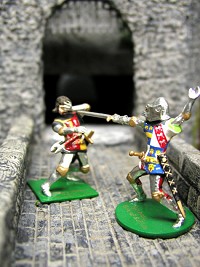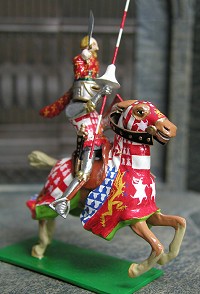
          |
Courtenay and His Heirs
Toy knights go back centuries, but the English maker Richard Courtenay (1892 – 1963) took them to a whole new level. Courtenay’s figures were more than toys; he produced exquisitely sculpted 54mm knights painted in authentic heraldry. Forty years after his death, his knights are still eagerly sought by collectors. The figure of King Edward II displaying his infant son (the future Edward II) on his shield was my first Courtenay; I found it in New Orleans one Mardi Gras. The Knight of the Garter is a more recent addition to the collection.
A pair of Richard Courtenay’s knights crossing swords. I don’t own either of these guys; I only wish I did.
The oldest Courtenay figures date back to the 1930s, and even the “newest” were made when John F. Kennedy was in the White House. After so long, it is hardly surprising that many Courtenay pieces show their age. Mint and near-mint figures are rare. Knights with breaks and repairs (swords and helmet crests are especially vulnerable), fading, and paint chips are far more common. There are only so many Courtenays in the world, however (experts estimate that he made perhaps 10,000 figures during his career), so broken and chipped pieces still have value. In the right hands, they can even recapture some of their lost glory through careful restoration. Witness this M2 figure of the great French knight Bertrand du Guesclin. A nice piece marred by huge paint chips, it was beautifully restored by Jacques Cuypers of Tiffany Soldiers, painting in the style of Courtenay.
Freddie Ping inherited the great Richard Courtenay’s molds when Courtenay died in 1963, and made “Courtenay-Ping” knights until his own death in 1977. Ping loved to vary the poses, however, as in this dramatic double.
The mounted knight that Courtenay numbered the H-13 was one of his most dramatic figures, and is much sought after by collectors. This is Freddie Ping’s version, painted here as William de Clinton, Erle of Huntingdon. Ping painted in a looser style than Courtenay, and used mattes where Courtenay preferred gloss, so their figures can easily be distinguished.
The “Tournament Knight” pose was one of Courtenay’s most popular mounted figures. His version can be seen here on the right, in the blue and gold heraldry of William, Earl of Wilts, K.G. On the left is a Courtenay-Ping figure from the same casting, painted as Sir Andrew Bures. The Courtenay is painted in gloss, the Ping in matte. Courtenay’s knight has a removable helm and a nicely painted face beneath; Ping’s does not. On both figures, the lance arm moves.
Freddie Ping was one of the world’s most renowed miniaturists in his own right before he began producing Courtenay-Ping knights from the Courtenay molds. He created exquisite portrait figures from scratch, no two alike, using sheet lead for cloaks and gowns. English royalty was a favorite subject. Here are two of his figures: King John, with the Magna Carta, and Katherine of Aragon draped in a heraldic cloak.
The charming couple in the castle gate are King Edward III and his queen, the fertile Philippa of Hainault, from whose womb the Wars of the Roses sprang forth. She gave King Edward thirteen children, including five robust sons whose loving descendants would slaughter one another over the English throne for generations. The miniature of King Edward is an original figure by Freddie Ping. Queen Philippa was cast from a Courtenay mold. Ping’s painting was looser and more impressionistic than Courtenay’s. On close inspection, for instance, Ping’s character fleur de lis has a certain phallic look to it…
These triplets were separated at birth. The figure on the left is an original of Jean the Good, by Richard Courtenay. In the middle is a ripoff of same, done in the 50s by the Japanese toymaker Minikin. On the right is a Minikin figure that has been beautifully repainted by Bob Hornung of Cincinnati as John Howard, Duke of Norfolk. 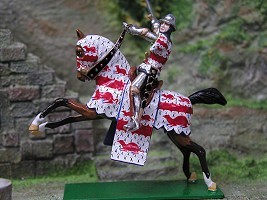
The Glory of Greenhill Peter Greenhill acquired the Courtenay molds after the death of Freddie Ping in 1977 and continues to produce Courtenay-Greenhill knights to the present day. His wife Gilly casts the figures, while Peter does the painting. Greenhill is also the author of Heraldic Miniature Knights, the definitive book on the subject and the “Bible” for every Courtenay collector. Here’s the Greenhill version of Courtenay’s rare “rocking horse knight,” done in the arms of Sir William Islip. This vignette has Michael de la Pole, Earl of Suffolk, wounding Sir Henry Percy, better known to history as Hotspur. A rather unlikely event, admittedly; the two were not contemporaries, and Hotspur was much the better fighter. But I love the quartered heraldry, especially as rendered by Greenhill. The castings are Courtenay’s Z11 and Z17 poses, respectively. 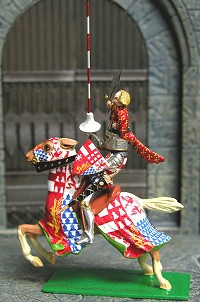
Sir Anthony Wydville Sir Anthony Wydville, Lord Rivers, was the greatest tournament knight of his day. His epic meeting with the Bastard of Burgundy is still remembered among those of a chivalrous bent. Rivers was the brother of King Edward IV’s beautiful but ambitious queen, Elizabeth Wydville, and the guardian of her young son, Edward V, the elder of the two “princes in the tower.” While escorting the young king to London for his coronation, he was met at Stony Stratford and arrested by Richard of Gloucester (Richard III) and his ally Buckingham. Edward V went to the Tower of London, never to emerge, whilst Rivers and several of the other Wydvilles were imprisoned and soon executed. A magnificent jouster, esteemed for his gallantry, courage, and piety, Sir Anthony died without a fight… which just goes to prove that life can be crueler and less satisfying than fiction. Here he is in all his tourney splendor, however, courtesy of Greenhill Miniatures. The figure is Courtenay’s H-4 pose, though modified to give Rivers a lance in place of a sword. The gorgeous heraldic painting is by Peter Greenhill. Gilly Greenhill created Sir Anthony’s distinctive and unusual helmet crest of a moor armed with a scimitar. |











 Two Figures by the Master
Two Figures by the Master Dueling Courtenays
Dueling Courtenays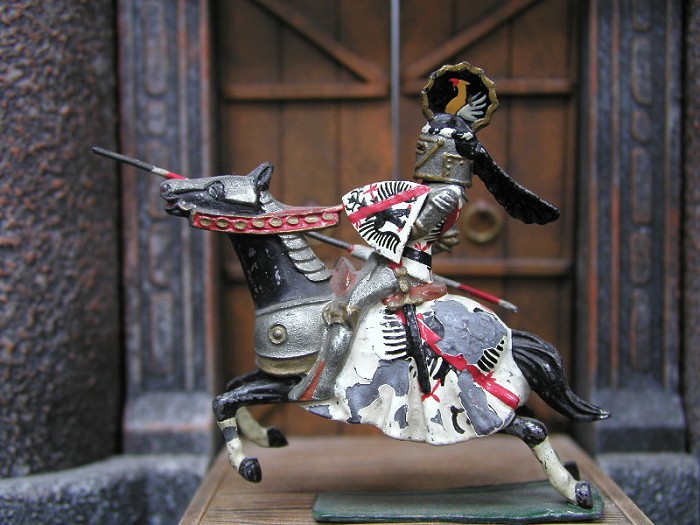
 Before and After
Before and After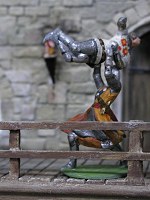 Fight on the Balcony
Fight on the Balcony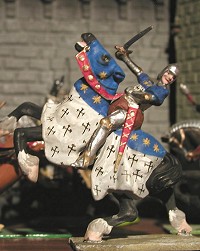 Charging Into Battle
Charging Into Battle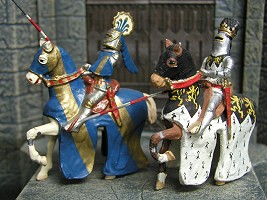 Almost Twins
Almost Twins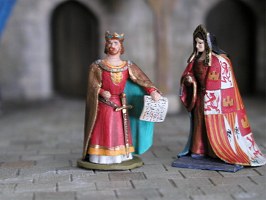 The Late Great Ping
The Late Great Ping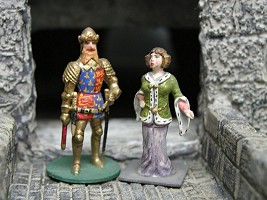 Another Pair O’ Pings
Another Pair O’ Pings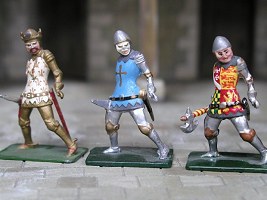 Triplets
Triplets